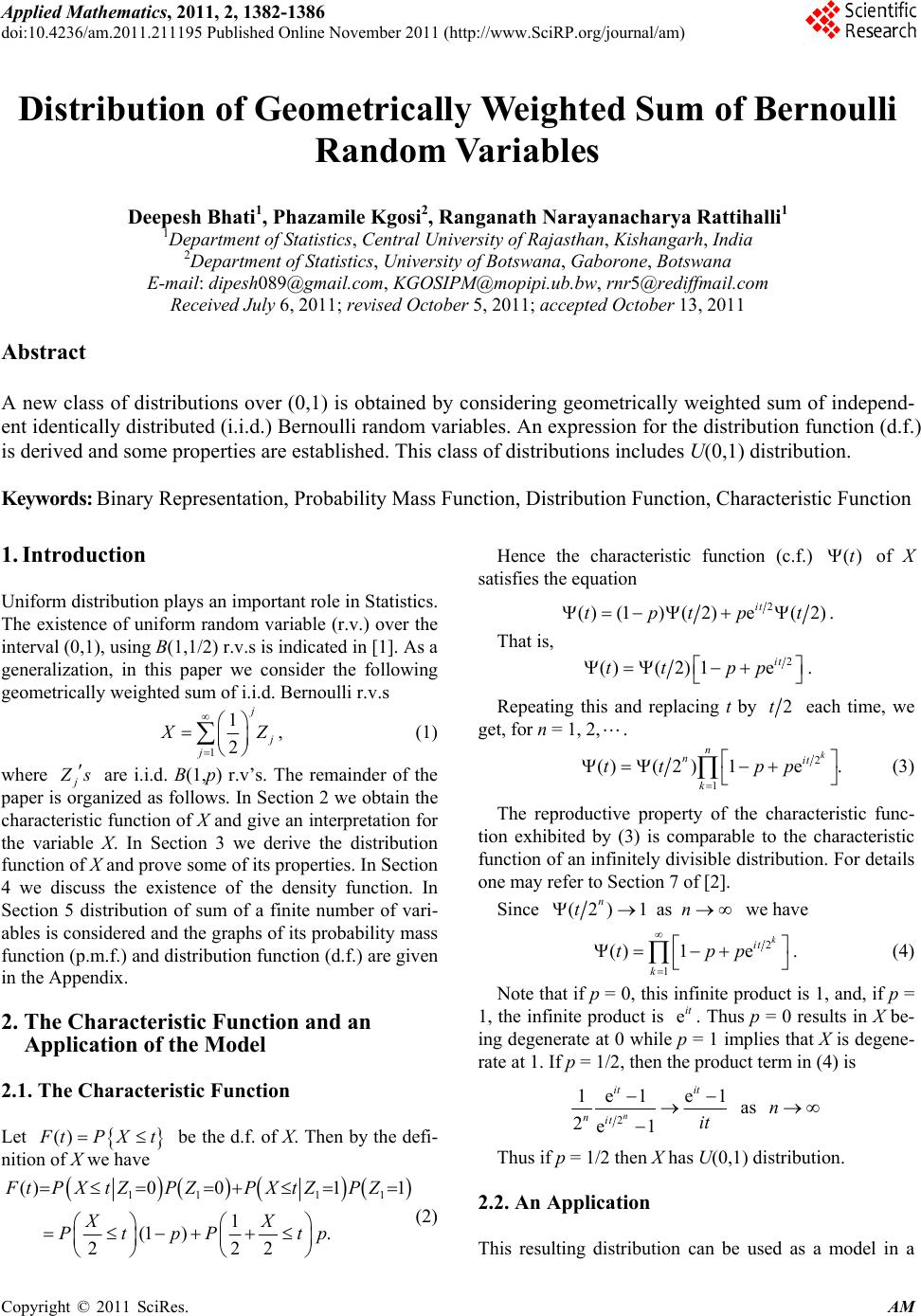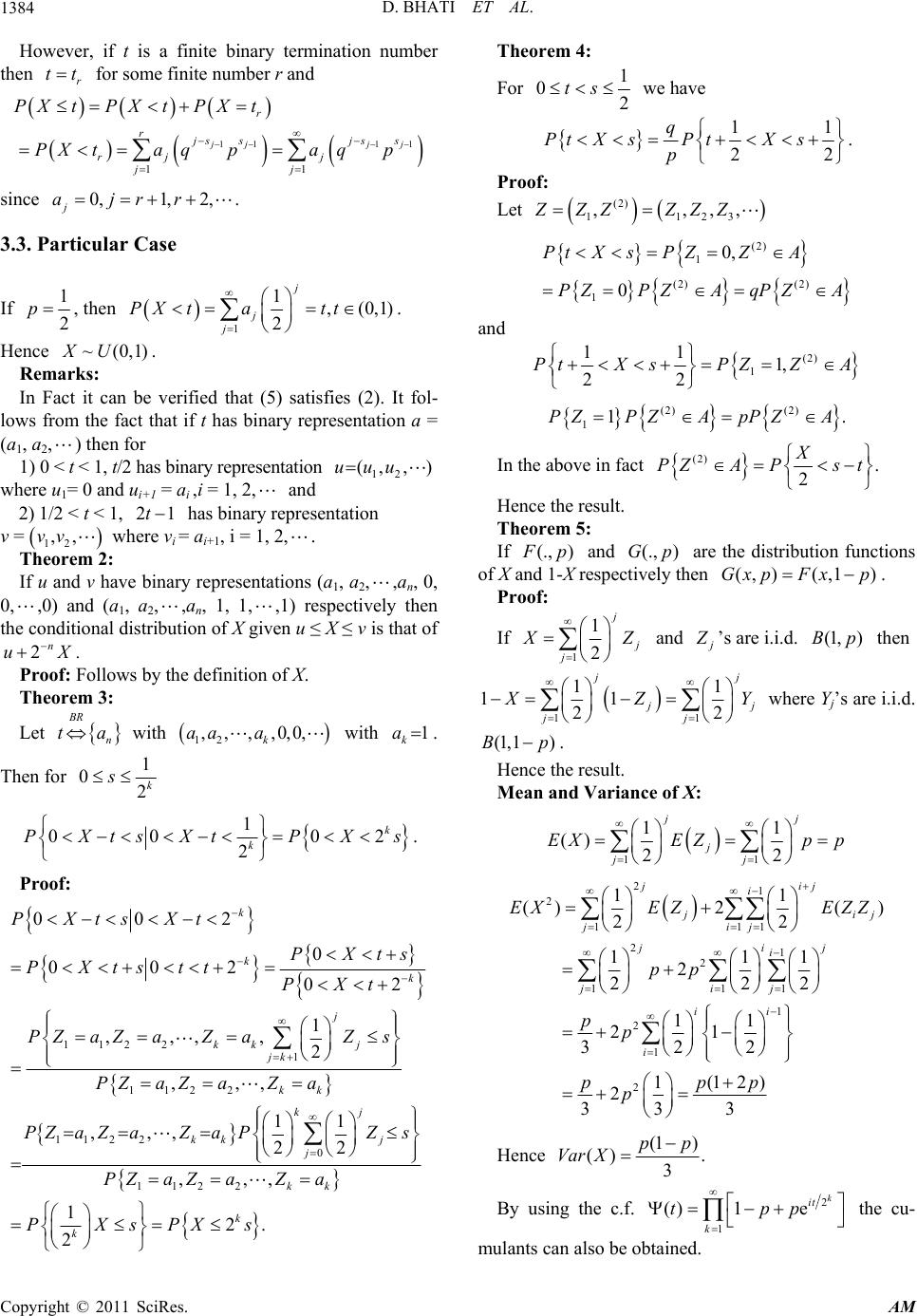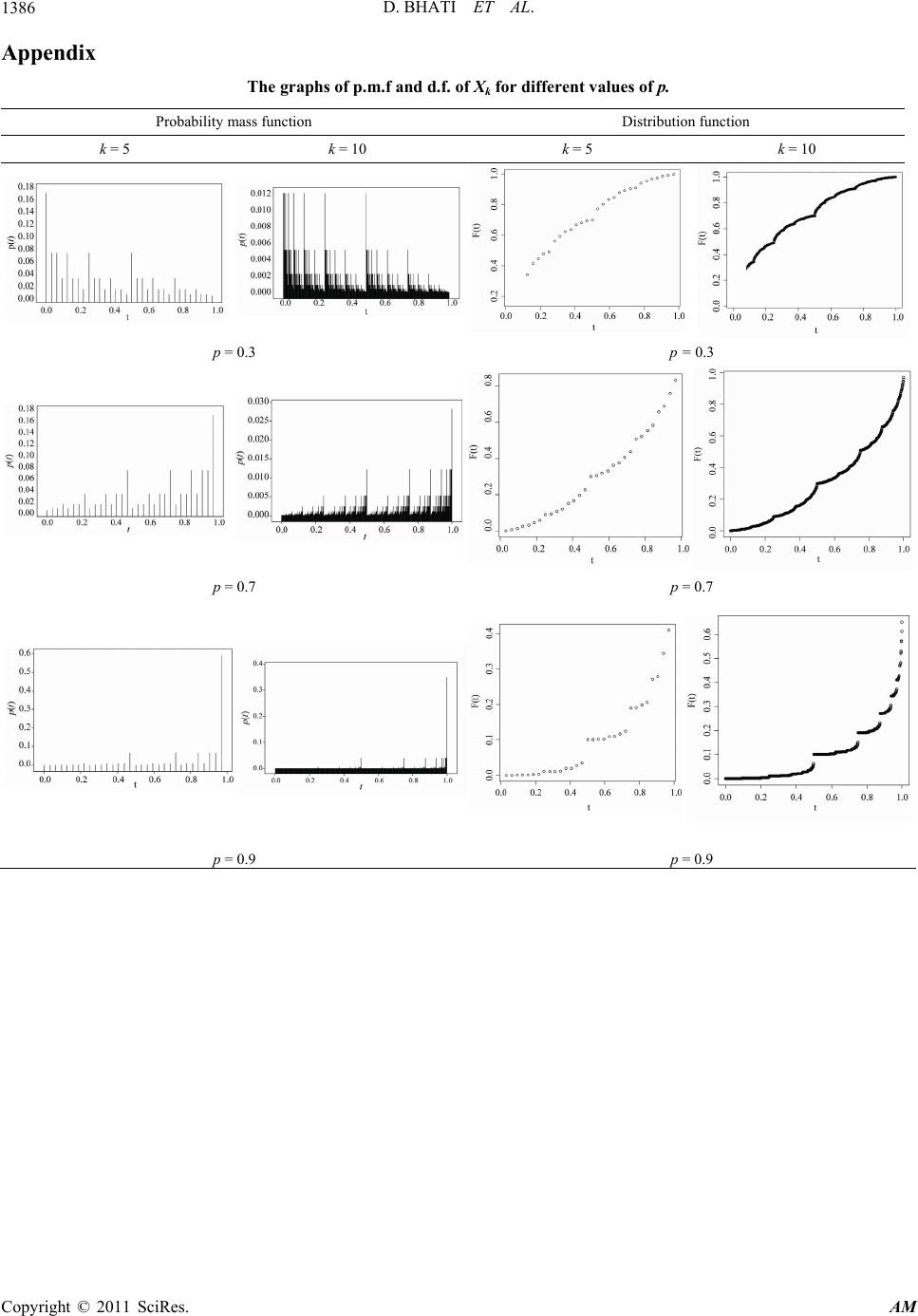Paper Menu >>
Journal Menu >>
 Applied Mathematics, 2011, 2, 1382-1386 doi:10.4236/am.2011.211195 Published Online November 2011 (http://www.SciRP.org/journal/am) Copyright © 2011 SciRes. AM Distribution of Geometrically Weighted Sum of Bernoulli Random Variables Deepesh Bhati1, Phazamile Kgosi2, Ranganath Narayanacharya Rattihalli1 1Department of Stat i s t i c s, Central University of Rajasthan, Kishangarh, India 2Department of Stat i s t i c s, University of Botswana, Gaborone, Botswana E-mail: dipesh089@gmail.com, KGOSIPM@mopipi.ub.bw, rnr5@rediffmail.com Received July 6, 2011; revised October 5, 2011; accepted October 13, 2011 Abstract A new class of distributions over (0,1) is obtained by considering geometrically weighted sum of independ- ent identically distributed (i.i.d.) Bernoulli random variables. An expression for the distribution function (d.f.) is derived and some properties are established. This class of distributions includes U(0,1) distribution. Keywords: Binary Representation, Probability Mass Function, Distribution Function, Characteristic Function 1. Introduction Uniform distribution plays an important role in Statistics. The existence of uniform random variable (r.v.) over the interval (0,1), using B(1,1/2) r.v.s is indicated in [1]. As a generalization, in this paper we consider the following geometrically weighted sum of i.i.d. Bernoulli r.v.s 1 1 2 j j j X Z , (1) where j Z s are i.i.d. B(1,p) r.v’s. The remainder of the paper is organized as follows. In Section 2 we obtain the characteristic function of X and give an interpretation for the variable X. In Section 3 we derive the distribution function of X and prove some of its properties. In Section 4 we discuss the existence of the density function. In Section 5 distribution of sum of a finite number of vari- ables is considered and the graphs of its probability mass function (p.m.f.) and distribution function (d.f.) are given in the Appendix. 2. The Characteristic Function and an Application of the Model 2.1. The Characteristic Function Let () F tPXt be the d.f. of X. Then by the defi- nition of X we have 11 11 ()001 1 1 (1 ). 222 FtP XtZPZPXtZPZ XX PtpP tp (2) Hence the characteristic function (c.f.) ()t of X satisfies the equation 2 ()(1)( 2)e(2) it tptpt . That is, 2 ()(2) 1e it tt pp . Repeating this and replacing t by 2t each time, we get, for n = 1, 2,. 2 1 ()(2 )1e. k n nit k tt pp (3) The reproductive property of the characteristic func- tion exhibited by (3) is comparable to the characteristic function of an infinitely divisible distribution. For details one may refer to Section 7 of [2]. Since (2)1 as n tn we have 2 1 ()1e k it k tpp . (4) Note that if p = 0, this infinite product is 1, and, if p = 1, the infinite product is . Thus p = 0 results in X be- ing degenerate at 0 while p = 1 implies that X is degene- rate at 1. If p = 1/2, then the product term in (4) is eit 2 1e 1e 1 2e1 n it it nit it as n Thus if p = 1/2 then X has U(0,1) distribution. 2.2. An Application This resulting distribution can be used as a model in a  D. BHATI ET AL.1383 1 , situation similar to the following. Suppose a particle has linear movement on the interval [0,1]. To capture the particle suppose the following binary capturing tech- nique of dividing the existing interval into two equal halves is used. Suppose initially there are two barriers put at 0 and 1. After one unit of time a barrier is put at the midpoint of 0 and 1. Further the interval in which the particle is found is divided into two equal halves by placing a barrier at their midpoint and the process is con- tinued. The intervals containing the particle keep on shrinking and finally shrink to X, the point at which the particle is captured in the long run. The behavior of the particle is known only to the extent that at the moment of placing a barrier after exactly one unit of time the parti- cle is on the right side of the inserted barrier with prob- ability p. 3. Main Results 3.1. Notation It is known that every number t, has a binary representation through as 0t ,0or1 1 nn aa 1 1 2 i i i ta . If a number t has the representation 1 1, 1, 2 i k ik i ta a we refer t as a finite binary termi- nating number and such a number can be represented by for some . However such a number also can be represented as 2, k r1, 2,,21 k r 1 1,,1,2,, 2 0,1,1, 2, i iii i ki bbai k bbikk 1, It is to be noted that the right tail of the sequence {ai} is of the form (0,0,0 while that of the sequence {bi} is of the form (1,1,1, In the following as a matter of convention we do not consider representation with the right tail of the form (1,1,1,). Under such a convention, corresponds to a unique binary sequence ) ). [0,1]t 1 i a and conversely. If 1 1 2 i i i ta , then we shall denote this relation as , (BR to mean the binary representation). BR n ta 3.2. Properties Theorem 1: Let and BR n ta 1 k kj j s a , . Then the d.f. of X defined in (1) is given by 0 1, 2,,0ks 11 1 () jj js s j j FtP Xtaqp . (5) Proof: Let, 1 1 2 i i i ta and r be the rth non-zero element k a in the sequence ,1,2, i ar. Let be the number having the binary representation 12 r k and 0 r t ,aa(,, 0,0,)a 0t . It is to be noted that r is a finite binary terminating number. If t is not a finite binary terminating number then the sequence increases to t. If t is a finite binary terminating number then we note that r t tt r t for some finite r. For example, let have a binary rep- resentation 00010011000 and t 1234 4,7, 8, 11kkkk so that 1 B R t (001000, 2 0) B R t (00011003 00 0), B R t (000100110 so on. We note that 1 i a 00 ) and for ,,ik k and 0 12 3 ,k otherwise. Note that PXt ,1, 2,,1,1,0,1, 2,... 1,0,1, 2,0. rr rr r iir kkj kkj PZ aik ZZj PZ Zj Thus F does not have a jump at tr and r F tFt. ng number. WLet t be not a finite binary representie note that 1 1 11 00,, k k XtPZ Zq P0 111 2 2 121 11 1 0, ,0,1,0, ,0 kkk k k PtX tPZZZZ Zqp 111 3 222 3 23 111 22 11 0, ,0,1,0, ,0,1,0,,0 kkk k kkk k PtX tPZZZZ . Z ZZZ qp Thus in general for r = 1, 2, 3, we have (1)1 rr 1. r k rr PtX tqp Hence . (1)1 1 11 () r kr r rr rr PX tPtXtqp , r kj If we let then s, then we will have In fact F does not have jump at ant t, (0 < t < 1). Hence 1 1 1 1 j ij i ra 11 . jj js s q p 1 j j a ()PX t 11 1 . jj js s j j PX tPXtaqp Copyright © 2011 SciRes. AM  D. BHATI ET AL. 1384 t is a finite binary termination number th for some finite number r and since articular Case However, if en ttr r rjs s tPXtPX t 11 11 11 jj jj js s rj j jj PX PXta qpaqp Theorem 4: For 0,1, 2, j ajrr. 3.3. P If 1 p, then 2 1 1,(0,1) 2 j j j PXt att . ct it can befied that (5) satisfies (2). It fol- fact that if t has binary representation a = (a Hence ~(0 Remks: ,1)XU . ar In Fa veri lows from the 1, a2,) then for 1) 0 < t < 1, t/2 has binary representation 12 (, , ) uuu where u= 0 and ui+1 = a,i = 1, 2, and 1i tation 1 2an, 0, 2n rpectithen t Theorem 3: with 2) 1/2 < t < 1, 21t has binary represen rv = 12 ,,vv whee vi = ai+1, i = 1, 2,. Theorem 2: If u and vhave binary representations (a, a,, 0, , a,,a, 1, 1,,1) es,0) and (a1vely he 2 conditional distribution of X given u ≤ X ≤ v is that of n uX. Proof: Follows by the definition of X. R Let B ta with 12 ,,,,0,0, k aa a n1 k a . Then for 1 0s2k 1 0 P 002 2 k k XtsXt PXs . Proof: 1 02 ts we have 11 22 q PtXs PtXs p . Proof: Let (2) 1123 ,,,ZZZZZZ , (2) 1 (2) (2) 1 0, 0 Pt XsPZZA PZPZ AqPZ A and (2) 1 11 1, 22 PtX sPZZA (2) (2) 11.PZ ApPZ A In the above in fact PZ (2) . 2 X PZAPst Hence the result. 5: Theorem (.,If ) F p and are the diribution functions of respen If (., )Gp ectively th st X an) d 1-X Proof: (,(,1)Gxp Fxp. 1 1 2 j j j X Z and j Z ’s are i.i.d. ),1( pB then 11 11 11 22 jj 1122 1 1122 1122 0 1122 002 0 002 02 1 ,,,, 2 ,,, 11 ,,, 22 ,,, k k k j kk j jk kk kj kk j j PXtsXt PXts PXtstt PXt PZ aZaZaZs PZ aZaZa PZa ZaZaPZs PZ aZa 12. 2 kk k k Za PXsPXs j j jj ZY X where Yj’s are i.i.d. (1,1 )Bp . Hence the result. Mean and Va ri an ce of X: 1j1 1 () 22 jj jj EXEZpp 1 2 2 11 21 2 11 1 2 1 2 () 2 11 1 2 22 11 21 322 1(1 2 jij 1 1 11 2( ) 2 i 1 2 33 j ij j E EZZ i j jij i ji ii i X EZ pp pp pp p j 2) 3 p Hence (1 ) () . pp Var X 3 By using the c.f. 2 1 ()1e k it k tpp the cu- mulants can also be obtained. Copyright © 2011 SciRes. AM  D. BHATI ET AL. Copyright © 2011 SciRes. AM 1385 4. Nonexistence of Density Function We have proved that the distribution function of X is given by Let the left derivative and the right derivative of F at t exist. These be denoted by 11 1 () jj js s j j Fta qp , BR n ta. () f t and () f t respectively Consider . 1 2 f and 1 2 f , the right and left de- rivatives of F at 1/2. 1 1 111 122 2 lim 2 lim2 k k k 2 lim(2 )(2) k k kk FF f qp qp k and 1 1 limlim(2)(2 ). 2 k k kk pq pq 11 1 22k k k at 122 2 lim k FF f Note th1 2 f a nd 1 2 f are equal if and only if 1 pq. He 2t differentiable at 1/2 if nce F is no 1 2 p. Let :1,2,3,0,1,2,,2 2 k k r Dk r . It can be that F is not differentiable at each point of D and D is countable dense subset of [0,1]. Hence F is nowhere differentiable in [0,1]. 5. Distribution of Sum of a Finite Numbr of Bernoulli Random Variables Since F(t) is an infinite series for t not in D, the exact eva- lu is not pe for eac ing we se- over, the density function of X does not exist on the in- terval (0,1). Hence in the follow consider the quence {Xk} of r.v. defined by shown the set e ation of F(t)ossiblh (0,1).t More- 1 1. 2 i k ki i X Z (6) The sequence k X increases point wise to X and 2. k k XX Similar to (5), it can be shown that for 1 1 2 j j j ta , k 11 1 ()( ) jj js s kj j F taqpF the d.f. of Xk is s, wh j ere 1 1. 2 k j sa Further, at these values of s, j () () k F sFs and va the difference between two successive lues of s ’s is 2k , as such the two functions () k F t and () F t are almost alike. Si iso X the nce the sequen sequence {Fk(t)} de ce {Xk} creasesincreases point we t to F(t) for (0, 1)t . k We note that for p = 1/2, ()( ) F tFs. The gra 5 phs of p.m.f anX10 for different values of d d.f. of X and 1 2 p are gi H. J. Vama of the paper. . References ] S. Kunte and R. N. Rattihalli, “Uniform Random Vari- n, Academic Press, Cambridge, 2001. ven in the Appendix. 6. Acknowledgements We are thankful toor Professn, Central Uni- versity of Rajasthan, India, for the discussions which helped to improve the content and the presentation 7 [1 able. Do They Exist in Subjective Sense?” Calcutta Sta- tistical Association Bulletin, Vol. 42, 1992, pp. 124-128. [2] K. L. Chung, “A Course in Probability Theory,” 3rd Edi- tio  D. BHATI ET AL. 1386 Appendix The graphs of p.m.f and d.f. of Xk for different values of p. Probability mass function Distribution function k = 5 k = 10 k = 5 k = 10 p = 0.3 p = 0.3 p = 0.7 p = 0.7 p = 0.9 p = 0.9 Copyright © 2011 SciRes. AM |

